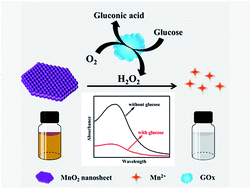A novel one-step colorimetric assay for highly sensitive detection of glucose in serum based on MnO2 nanosheets†
Abstract
Glucose provides essential function towards metabolism processes in biological systems and has close relationships with diabetes or hypoglycemia. In this work, a very simple, one-step colorimetric method based on MnO2 nanosheets for highly sensitive glucose detection is proposed. Glucose can be efficiently catalyzed by using glucose oxidase (GOx) to generate gluconic acid and hydrogen peroxide (H2O2). Consequently, the obtained H2O2 triggers the rapid decomposition of MnO2 nanosheets and generates an obvious absorbance change at 370 nm. By simply monitoring the absorbance variation, a low detection limit of 0.17 μM for glucose was obtained with a linear range from 0.5 μM to 50 μM by visual observation and quantitative analysis. In addition, the proposed method was successfully applied to the determination of glucose in serum with satisfactory recoveries. This proposed strategy is very fast, convenient, and environmentally friendly and requires no sophisticated instruments as well as complicated functional nanomaterials, which reveals that this method has great potential for diabetes mellitus study and biosensing applications.



 Please wait while we load your content...
Please wait while we load your content...